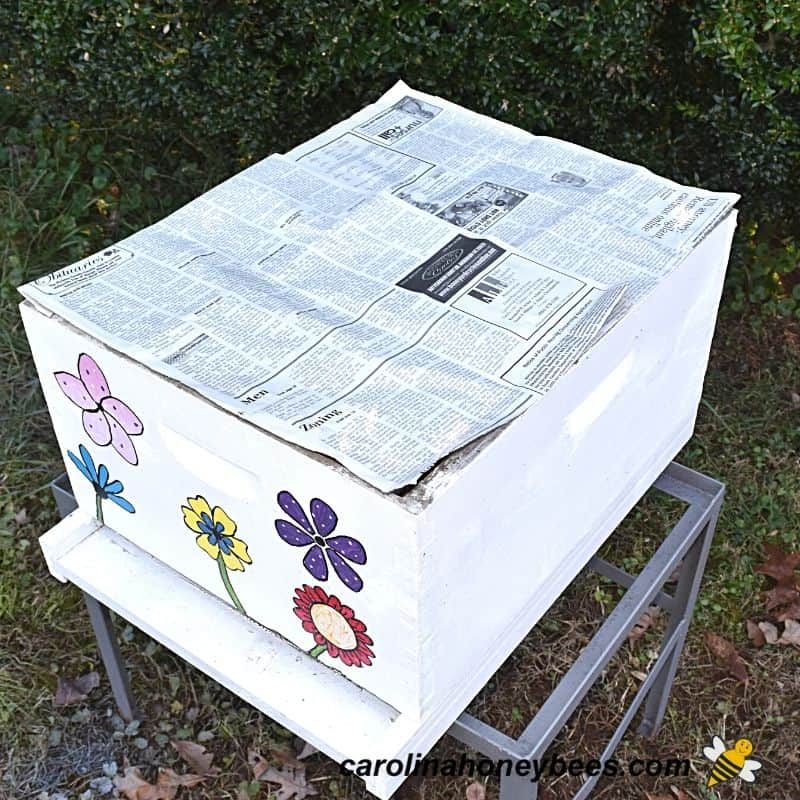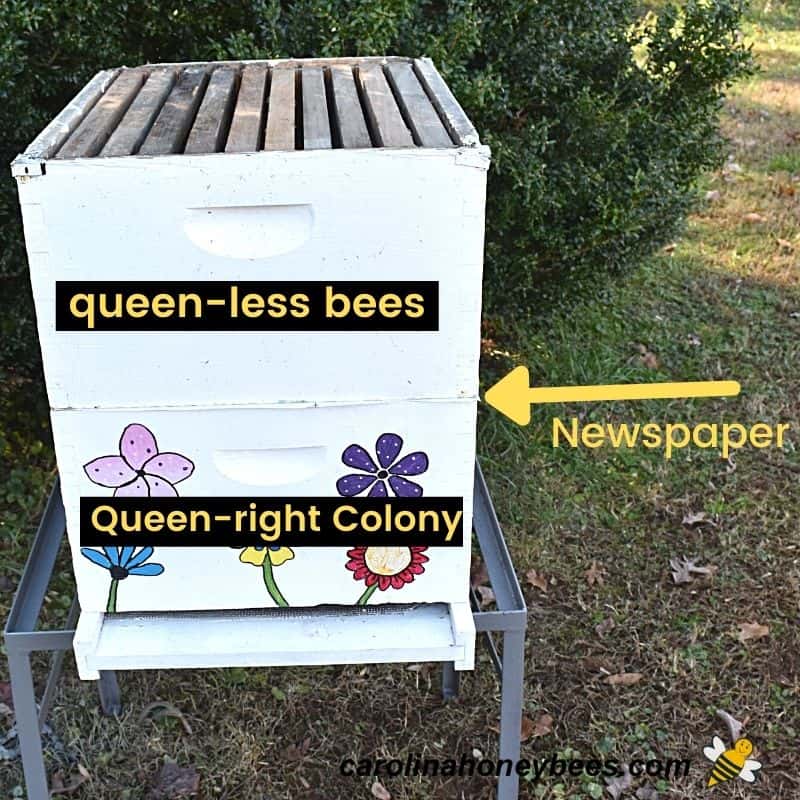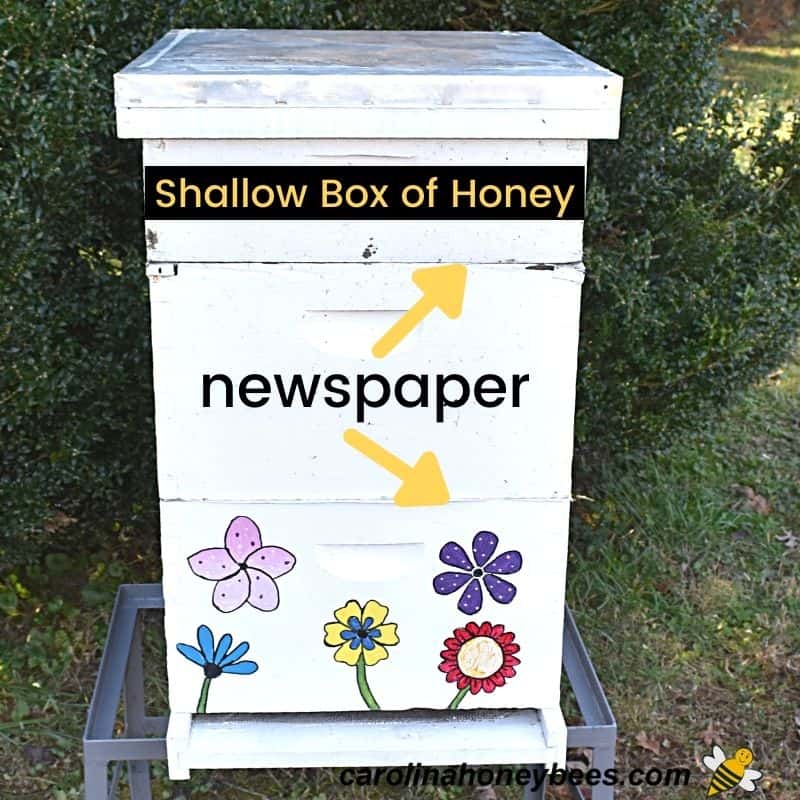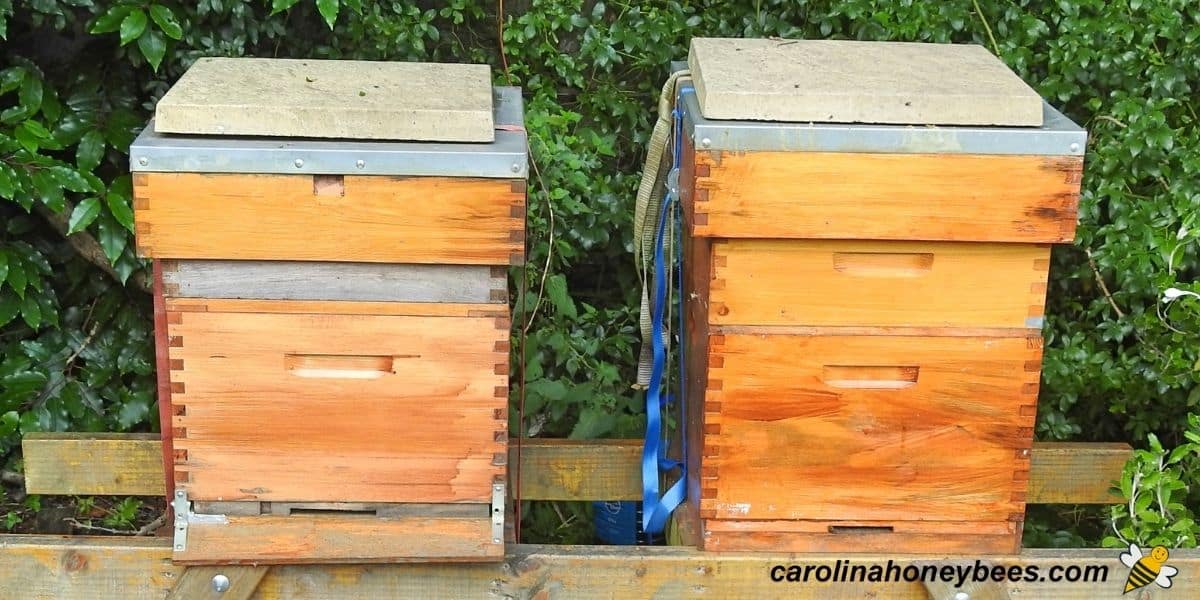Combining Two Beehives
Every beekeeper needs to know how to combine two beehives into one. Unfortunately, not every colony grows and produces equally. In most apiaries, there comes a time when combining hives is a smart strategy. One of the easiest ways to combine colonies is with newspaper. When done correctly, you can end up with one strong productive colony instead of two small non-productive hives.

As a Master Beekeeper with a few years experience, I have combined many bee colonies together. It is a good hive management strategy – especially if you have hives that may be too small going into Winter.
Combining Two Bee Colonies
Since most beekeepers like the idea of having a larger number of hives, why would anyone want to combine 2 beehives into one? Can having fewer hives in your bee yard actually be a good thing? Yes, it can.
Before you begin, it is important to understand some basic hive dynamics. Making their home inside “a beehive” (man-made or a hollow tree), members of the colony recognize each other using “scent” or bee pheromones.
Rather than throwing two colonies of bees together in a box and letting them fight it out. The smart approach is to allow a slow introduction and hopefully more peaceful union.

Steps to Combine Two Hives with Newspaper
There are many ways to put 2 colonies in one hive. Every beekeeper has a preference and likes his/her way best. Keep this in mind.-do what works for you and your style of beekeeping. This is my method.
A newspaper combine works by allowing the members of both boxes (hive families) to hear and smell each other.
But, it takes a few hours to for the workers to chew through the paper with the bees’ teeth or mandibles. Hopefully this short acclimation process results in reduced fighting.
- choose the base queen right hive
- prepare the weaker colony for the move
- open the queen right hive and place newspaper
- add weaker hive box to the base
- close up the hive
- recheck for success
1. Identify a Queen Right Hive as a Base
Choose the colony with the largest population of bees as the base. With the most workers, it has the most bees in the field collecting resources.
They will be returning to their hive – we probably don’t want to move it. We also hope that this stronger hive has a queen laying a good brood pattern.
2. Prepare the Weaker Colony
The second hive is our weaker colony – let’s prepare it for the merge. It also has a 10 frame deep box-but only a few frames of bees. In addition to no queen, their population is very low.
They have no bee brood (or just a bit on a frame of two) so we know they have been struggling for a while. Maybe they have some stored bee bread and honey.

If you have several frames of brood in the weaker colony – it is good to consolidate them into one bottom box. Ideally, we want all the brood in the a single bottom deep. But, this is not always possible.
Arrange frames with open brood (eggs and bee larvae – if there is any) in the middle of a bottom box.
If a poor performing queen is present – it is best to remove and squish her once you are positive that the larger hive is queen right.
The stronger colony of bees will likely kill the other queen so why let them go through that process. It can result in more worker deaths than necessary.
If you have an aggressive colony (being without a queen will do that), don’t bother to search through the frames – the bees will just have to work things out.
If you can put all the frames with bees into one box – that makes things easy. Remember this is the weaker colony that we are preparing to sit on another hive.

3. Place Newspaper on the Base Hive & Combine
Place a sheet or two of newspaper over the top bars of the populous hive. This is going to be the bottom box sitting on the bottom board.
Try to use newspaper that is mostly black and white (at least not a lot of color) to reduce the ink in the hive. You can very lightly spray the newspaper with sugar water if you want-but it is not necessary.
Now, sit the second hive body (containing the weaker colony) with no queen and a smaller population on top of the newspaper. It is okay that the top box does not have an entrance, there should be some honey in the frames.
Over the next few days, the bees will eat through the newspaper and work things out. The stronger family will protect their queen and the two populations should merge peacefully.

4. Close up Hive
Close up the combined hives by placing the inner cover and telescoping top in place. At this point, some beekeepers choose to close up the hive entrance for a day or so. I am not a fan of adding that stress to the bees. I do not close up my combined hives.
5. Hive Inspection Recheck in 1 Week
The sheets of newspaper between the two deeps will allow the 2 different bee families to slowly become introduced. This should result in less fighting and result in one viable colony.
In a week, it is time for a hive inspection. Open the hive and check for a laying queen and brood. Now is a good time to condense all the brood frames into the bottom hive body or brood box (if needed).
Expert Tips for Merging Bee Colonies
This method of combining bee colonies with newspaper works well. If both hives were already sitting close together, returning forager bees should have no trouble finding their sisters.
Do keep in mind that we are basically “moving a beehive” – even if it is only 1 box. If the original location of the small colony was several feet away, any of its returning foragers may be lost. If you are lucky enough to have several hives, they may be allowed to join one nearby.
Remove any left over equipment from the dismantled hive from the bee yard. It will only cause confusion.
After a successful combine it is time to remove that extra deep box. (unless you normally use 2 deeps in your hive setup).
We do not want to leave all of this space for a colony-unless they have abundant population to patrol the comb. Otherwise, you may have problems with pests such as wax moths or Small Hive Beetles.

Hive Combining with a Food Super
Many beekeepers use a hive configuration of one deep and 1 shallow or medium. I had a special situation where the strong hive was very strong and the food super box full. I had no place to store this super of honey during the acclimation period.
In this case, you can put that food super full of honey on top. Just add another layer of newspaper between the boxes to allow for a slower introduction.
I would make sure that the queen of the colony is in the bottom deep if possible-but that is just my personal preference.

Reasons for Combining Beehives
While there are several times that combining colonies may be a smart move – these are the most common.
- one colony is without a queen (or resources to make one)
- a hive has become very low in population
- combining weak colonies in Fall for better Winter survival rates
Combine a Queenless Colony
Honey bees have a great system for making a new queen. They only need a viable population (enough workers to sustain the colony) and some fertilized honey bee eggs or very young worker larvae.
As remarkable as the queen replacement strategy is – it doesn’t always work. Combining a hopelessly queenless colony with a queen right hive is a sound strategy.
Boost Population in a Hive
Honey bees do not live long. That’s why we need a constant source of new workers coming along. Sometimes a hive will lose population due to no fault of sickness or disease.
If not enough worker eggs are being laid, colony population drops quickly and may reach a point of no return.
Perhaps the honey flow is a couple of weeks away and the beekeeper finds herself (himself) with 4 small colonies.
Combine these 4 small healthy colonies into 2 strong ones and now you have good production hives with a chance of producing a good honey harvest.
Taking Your Loses in the Fall
Another common reason to combine beehives is for better Winter management. I do this every year in my apiary. If you have 2 very small colonies in late Fall-that seem otherwise healthy, consider putting them together.
With little chance of surviving Winter cold alone, the combined population may allow them to make it to Spring. Look back in your beekeeping journal and attempt to diagnose why the colony is struggling.
FAQs
Yes. It is possible to combine two bee hives with a minimum of stress. The beekeeper should first decide which queen to keep – the new colony will only need one.
In most cases, honey bees acclimate to combined hives within 2-3 days. By then, the social order is established and the bees get down to regular business.
While it is possible to combine two beehives at any time of day, late afternoon into early evening is the most peaceful time when fewer bees are returning to the hives.
Yes, you can combine two queenless hives but unless you give them fresh worker eggs or tiny larvae they will still be doomed. They must have the materials to make a new queen.
Final Thoughts
This process of combining two beehives together with newspaper requires some time, and a bit of patience. However, it is a viable strategy for managing your colonies. Having 8 hives, with a handful of bees in each each, is not better than having 4 strong productive colonies.
I know from experience that 5 strong colonies will do better and produce more honey per hive than 10 weak ones. But, I must admit that newspaper is getting harder to find

